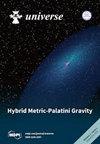UHECR 星团:来自局部片状星系的最亮星核
IF 2.5
4区 物理与天体物理
Q2 ASTRONOMY & ASTROPHYSICS
引用次数: 0
摘要
超高能宇宙射线(UHECR)之谜是在一些基本结果的提示下被回顾的:聚类、各向异性、不对称、弯曲和成分随能量的变化。我们展示了来自最近的 AGN 或星爆源的最轻 UHECR 核(位于几 Mpc 地方片内)是如何充其量解释在数十 EeV 能量下观测到的热点集群的。在可能的本地银河系外候选源中,我们得出了极少数星系源的主要贡献。这些星系源位于距离本地片平面几 Mpc 的范围内,喷射出几十 EeV 能量的 UHECR。UHECR 也以几 EeV 的较低能量闪耀,部分为 LMC 和可能更近的几个星系源的奥杰偶极子提供能量。对于最近的最高能量 UHECR 事件,如果是一个核子,则可以用一个基于 UHE ZeV 中微子对低质量遗迹中微子的散射的模型来解释。这种散射能够通过 Z 玻色子共振将 GZK 边界以上的最遥远宇宙源与这种神秘的 UHECR 事件联系起来。否则,如果这些极端事件是由最重的成分造成的,那么它们可能来自最重原子核的最大弯曲轨迹或附近的来源,甚至银河系来源。总之,目前来自本地片的从最轻核到最重核的 UHECR 模型可以成功地将 UHECR 聚类与最近的星系和 AGN 联系起来。重UHECR可能会从本片或过去的星系、GRB或SGR爆炸性抛射中广泛偏转而发光。本文章由计算机程序翻译,如有差异,请以英文原文为准。
UHECR Clustering: Lightest Nuclei from Local Sheet Galaxies
The ultra-high-energy cosmic ray (UHECR) puzzle is reviewed under the hints of a few basic results: clustering, anisotropy, asymmetry, bending, and composition changes with energies. We show how the lightest UHECR nuclei from the nearest AGN or Star-Burst sources, located inside a few Mpc Local Sheets, may explain, at best, the observed clustering of Hot Spots at tens EeV energy. Among the possible local extragalactic candidate sources, we derived the main contribution of very few galactic sources. These are located in the Local Sheet plane within a distance of a few Mpc, ejecting UHECR at a few tens of EeV energy. UHECR also shine at lower energies of several EeV, partially feeding the Auger dipole by LMC and possibly a few nearer galactic sources. For the very recent highest energy UHECR event, if a nucleon, it may be explained by a model based on the scattering of UHE ZeV neutrinos on low-mass relic neutrinos. Such scatterings are capable of correlating, via Z boson resonance, the most distant cosmic sources above the GZK bound with such an enigmatic UHECR event. Otherwise, these extreme events, if made by the heaviest composition, could originate from the largest bending trajectory of heaviest nuclei or from nearby sources, even galactic ones. In summary, the present lightest to heavy nuclei model UHECR from the Local Sheet could successfully correlate UHECR clustering with the nearest galaxies and AGN. Heavy UHECR may shine by being widely deflected from the Local Sheet or from past galactic, GRB, or SGR explosive ejection.
求助全文
通过发布文献求助,成功后即可免费获取论文全文。
去求助
来源期刊

Universe
Physics and Astronomy-General Physics and Astronomy
CiteScore
4.30
自引率
17.20%
发文量
562
审稿时长
24.38 days
期刊介绍:
Universe (ISSN 2218-1997) is an international peer-reviewed open access journal focused on fundamental principles in physics. It publishes reviews, research papers, communications, conference reports and short notes. Our aim is to encourage scientists to publish their research results in as much detail as possible. There is no restriction on the length of the papers.
 求助内容:
求助内容: 应助结果提醒方式:
应助结果提醒方式:


